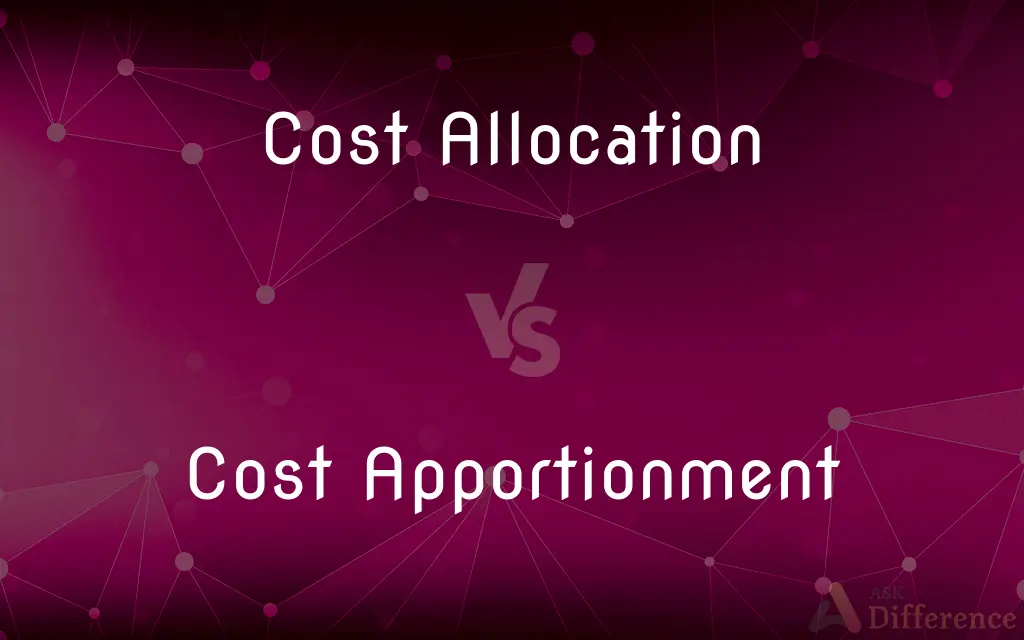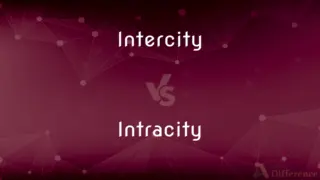Cost Allocation vs. Cost Apportionment — What's the Difference?
By Tayyaba Rehman — Published on October 8, 2023
Cost Allocation assigns costs to cost objects directly, while Cost Apportionment divides costs among different departments or units proportionately.

Difference Between Cost Allocation and Cost Apportionment
Table of Contents
ADVERTISEMENT
Key Differences
Though these concepts serve the common purpose of accurate cost assignment and distribution, they differ in approach, application, and complexity. Cost Allocation directly links costs to cost objects, ensuring precise cost measurements and aiding in accurate pricing and profitability analysis, while Cost Apportionment systematically distributes indirect costs, facilitating equitable sharing of common costs and enhancing cost control and decision-making.
Tayyaba Rehman
Oct 08, 2023
Cost Allocation and Cost Apportionment are pivotal accounting concepts used in assigning and distributing costs. Cost Allocation is the process of assigning costs directly to cost objects, like products or services, without any division or apportionment. It is typically straightforward and occurs when the cost can be directly identified with a specific cost center or cost unit, such as direct labor costs or direct materials costs, enabling precise cost calculations and profitability analysis.
Tayyaba Rehman
Oct 08, 2023
Cost Apportionment, however, involves the division and distribution of costs among different departments or units based on a certain proportion or basis. This usually pertains to indirect costs that cannot be directly assigned to a specific cost center or cost unit, such as rent, utilities, or administrative expenses. Apportionment requires an equitable basis for distributing these costs, such as floor space occupied or hours worked, to ensure accuracy and fairness in cost distribution.
Tayyaba Rehman
Oct 08, 2023
In essence, while Cost Allocation targets specific, directly attributable costs, Cost Apportionment deals with distributing shared, indirect costs among various cost centers or units. Cost Allocation is simpler, assigning costs directly without division, whereas Cost Apportionment is more complex, involving proportional distribution of costs based on certain criteria or bases.
Tayyaba Rehman
Oct 08, 2023
Comparison Chart
ADVERTISEMENT
Complexity
Simple, direct assignment
More complex, proportional distribution
Tayyaba Rehman
Oct 08, 2023
Purpose
Precise cost calculations and profitability analysis
Equitable sharing of common costs, enhanced cost control, and decision-making
Tayyaba Rehman
Oct 08, 2023
Definitions
Cost Allocation
Cost Allocation refers to attributing costs directly without any division.
The company uses cost allocation to assign direct labor costs to each unit produced.
Tayyaba Rehman
Oct 01, 2023
ADVERTISEMENT
Cost Apportionment
Cost Apportionment is the proportional distribution of indirect costs among various departments or units.
Cost Apportionment is essential to distribute the utility costs equitably among different departments.
Tayyaba Rehman
Oct 01, 2023
Cost Allocation
Cost Allocation is a straightforward method of assigning direct costs without apportionment.
Cost allocation is used to directly assign material costs to the production of each unit.
Tayyaba Rehman
Oct 01, 2023
Cost Apportionment
Cost Apportionment involves dividing and distributing shared costs based on certain criteria or bases.
The company uses floor space as a basis for the cost apportionment of rent among departments.
Tayyaba Rehman
Oct 01, 2023
Cost Allocation
Cost Allocation allows for accurate costing and profitability analysis of products or services.
Through cost allocation, the firm could identify the most and least profitable products in its portfolio.
Tayyaba Rehman
Oct 01, 2023
Cost Apportionment
Cost Apportionment facilitates the equitable sharing of common, indirect costs.
Through cost apportionment, each department bears a fair share of administrative expenses.
Tayyaba Rehman
Oct 01, 2023
Cost Allocation
Cost Allocation is the direct assignment of costs to cost objects.
Cost Allocation is crucial for accurately determining the production cost of each product.
Tayyaba Rehman
Oct 01, 2023
Cost Apportionment
Cost Apportionment enhances cost control and decision-making by systematically allocating indirect costs.
The cost apportionment of shared resources aids management in budgeting and cost control.
Tayyaba Rehman
Oct 01, 2023
Cost Allocation
Cost Allocation involves linking costs specifically and directly to products or services.
Precise cost allocation enables the company to set product prices based on actual production costs.
Tayyaba Rehman
Oct 01, 2023
Cost Apportionment
Cost Apportionment is necessary when costs cannot be directly identified with cost objects.
For shared resources like electricity, cost apportionment ensures fair distribution of costs to all benefiting units.
Tayyaba Rehman
Oct 01, 2023
FAQs
What is Cost Allocation?
Cost Allocation is the process of assigning costs directly to cost objects, such as products or services, without division.
Tayyaba Rehman
Oct 08, 2023
How does Cost Allocation aid in profitability analysis?
Cost Allocation allows for accurate costing of products or services, enabling precise profitability analysis and pricing decisions.
Tayyaba Rehman
Oct 08, 2023
Is Cost Allocation applied to direct or indirect costs?
Cost Allocation is applied to direct costs that can be directly identified with a specific cost object.
Tayyaba Rehman
Oct 08, 2023
What is the purpose of Cost Apportionment?
Cost Apportionment ensures the equitable distribution of common, indirect costs, enhancing cost control and decision-making.
Tayyaba Rehman
Oct 08, 2023
Is Cost Apportionment more complex than Cost Allocation?
Yes, Cost Apportionment is generally more complex as it involves proportional distribution of costs based on certain criteria or bases.
Tayyaba Rehman
Oct 08, 2023
What does Cost Apportionment mean?
Cost Apportionment is the process of dividing and distributing indirect costs proportionately among different departments or units.
Tayyaba Rehman
Oct 08, 2023
When is Cost Apportionment used?
Cost Apportionment is used when indirect costs need to be equitably divided among different cost centers or units.
Tayyaba Rehman
Oct 08, 2023
How does Cost Allocation contribute to cost accuracy?
Cost Allocation contributes to cost accuracy by directly assigning costs to cost objects, avoiding apportionment errors.
Tayyaba Rehman
Oct 08, 2023
Does Cost Allocation involve any division of costs?
No, Cost Allocation involves direct assignment of costs without any division or apportionment.
Tayyaba Rehman
Oct 08, 2023
What type of costs is subject to Cost Apportionment?
Indirect costs, such as rent and utilities, are subject to Cost Apportionment since they are shared among different departments or units.
Tayyaba Rehman
Oct 08, 2023
Can Cost Allocation be used for indirect costs?
Typically, Cost Allocation is not used for indirect costs as it is meant for directly attributable costs.
Tayyaba Rehman
Oct 08, 2023
Can Cost Apportionment impact budgeting and cost control?
Yes, Cost Apportionment aids in budgeting and cost control by systematically allocating indirect costs to relevant departments or units.
Tayyaba Rehman
Oct 08, 2023
Author Spotlight
Written by
Tayyaba RehmanTayyaba Rehman is a distinguished writer, currently serving as a primary contributor to askdifference.com. As a researcher in semantics and etymology, Tayyaba's passion for the complexity of languages and their distinctions has found a perfect home on the platform. Tayyaba delves into the intricacies of language, distinguishing between commonly confused words and phrases, thereby providing clarity for readers worldwide.

















































